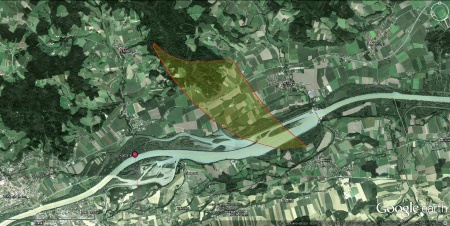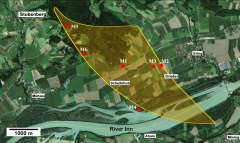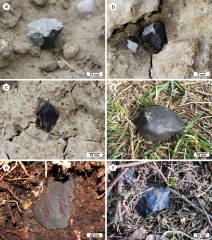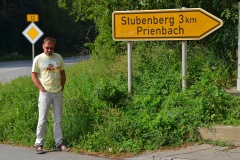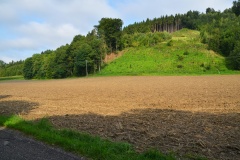(Unless otherwise stated, the copyright of the materials included belong to Jan Woreczko & Wadi.)
Stubenberg
Z Wiki.Meteoritica.pl
m (→Bibliografia) |
m (→Media) |
||
| (Nie pokazano 1 wersji pomiędzy niniejszymi.) | |||
| Linia 96: | Linia 96: | ||
Elipsa spadku i wygląd okazów (Bischoff et al. 2017): | Elipsa spadku i wygląd okazów (Bischoff et al. 2017): | ||
| - | <gallery caption="" widths=" | + | <gallery caption="" widths="240px" heights="240px" perrow="2"> |
File:Stubenberg_(Bischoff_2017_fig01).jpg|'''Figure 1.''' Calculated strewn field near Stubenberg (Germany) with find locations of the six recovered individuals (M1–M6). The northern part of the strewn field is dominated by forest, in which the samples M5 and M6 were found. Most other areas represent farmland. The river “Inn” marks the border to Austria in the south. Source of base map: Google Earth | File:Stubenberg_(Bischoff_2017_fig01).jpg|'''Figure 1.''' Calculated strewn field near Stubenberg (Germany) with find locations of the six recovered individuals (M1–M6). The northern part of the strewn field is dominated by forest, in which the samples M5 and M6 were found. Most other areas represent farmland. The river “Inn” marks the border to Austria in the south. Source of base map: Google Earth | ||
File:Stubenberg_(Bischoff_2017_fig02).jpg|'''Figure 2.''' Images of the six Stubenberg meteorites found between March 12 and April 3, 2016. a) This broken fragment, M1b, of 23.58 g is the largest part of 17 pieces, totaling 47.88 g. b) A chip of 0.45 g broke off from the individual meteorite M2 of 7.66 g at the impact in a field. c) The meteorite fragment M3 weighing 19.24 g was partially buried in the soft ground. d) Complete individual meteorite M4 of 42.43 g found on the northern bank of the river Inn. e) The impact hole of the largest Stubenberg individual meteorite M5 of 1320 g in the forest ground was 14 cm deep. f) The fragment M6 weighing 35.89 g shows fusion crust on the top, and broken faces at the bottom | File:Stubenberg_(Bischoff_2017_fig02).jpg|'''Figure 2.''' Images of the six Stubenberg meteorites found between March 12 and April 3, 2016. a) This broken fragment, M1b, of 23.58 g is the largest part of 17 pieces, totaling 47.88 g. b) A chip of 0.45 g broke off from the individual meteorite M2 of 7.66 g at the impact in a field. c) The meteorite fragment M3 weighing 19.24 g was partially buried in the soft ground. d) Complete individual meteorite M4 of 42.43 g found on the northern bank of the river Inn. e) The impact hole of the largest Stubenberg individual meteorite M5 of 1320 g in the forest ground was 14 cm deep. f) The fragment M6 weighing 35.89 g shows fusion crust on the top, and broken faces at the bottom | ||
</gallery> | </gallery> | ||
| - | <gallery caption="" widths=" | + | <gallery caption="" widths="240px" heights="160px" perrow="2"> |
File:Stubenberg_(Woreczko).jpg|''[[Redakcja]]'' na miejscu spadku meteorytu Stubenberg | File:Stubenberg_(Woreczko).jpg|''[[Redakcja]]'' na miejscu spadku meteorytu Stubenberg | ||
File:Stubenberg_(place_of_fall_sp1).jpg|Miejsce spadku okazu numer M1 | File:Stubenberg_(place_of_fall_sp1).jpg|Miejsce spadku okazu numer M1 | ||
| Linia 107: | Linia 107: | ||
| - | <gallery caption="" widths=" | + | <gallery caption="" widths="240px" heights="160px" perrow="2"> |
File:Stubenberg_(M5-cast_Dieter_Heinlein).jpg|Kopia okazu M5 meteorytu [[Stubenberg]] w ofercie Dietera Heinlein (w kolekcji jeszcze kopie: okazów meteorytu [[Morávka]], {{Txt2Img|Renchen_(M2-cast_Dieter_Heinlein).jpg|okazu M2}} meteorytu [[Renchen]] oraz okazu nr 2 meteorytu [[Jesenice]]) (fot. Dieter Heinlein) | File:Stubenberg_(M5-cast_Dieter_Heinlein).jpg|Kopia okazu M5 meteorytu [[Stubenberg]] w ofercie Dietera Heinlein (w kolekcji jeszcze kopie: okazów meteorytu [[Morávka]], {{Txt2Img|Renchen_(M2-cast_Dieter_Heinlein).jpg|okazu M2}} meteorytu [[Renchen]] oraz okazu nr 2 meteorytu [[Jesenice]]) (fot. Dieter Heinlein) | ||
</gallery> | </gallery> | ||
| Linia 147: | Linia 147: | ||
=== Media === | === Media === | ||
| - | {| | + | :{| |
| - | + | |<youtube height="240">qdi_QX0unrI</youtube> | |
| - | |<youtube | + | [http://youtu.be/qdi_QX0unrI Astronomové zveřejnili místo dopadu stovek meteoritů] (Pavel Spurný) |
| - | + | |<youtube height="240">d0JAAzXA3X8</youtube> | |
| - | + | [http://youtu.be/d0JAAzXA3X8 Stubenberg 5] | |
| - | | | + | |
|} | |} | ||
Aktualna wersja na dzień 21:27, 6 gru 2024
Leciał nad Austrią, zarejestrowali go w Czechach, spadł w Niemczech
| Stubenberg → | |
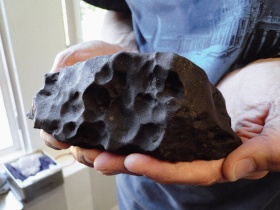
The largest fragment (1.32 kg) found within the Stubenberg meteorite strewn field (Bischoff et al. 2017; MaPS cover)
| |
| Spadek | |
| Lokalizacja | Stubenberg, Bawaria, Niemcy |
| Położenie[2] | 48°17'42"N, 13°07'00"E[1] |
| Data | 6 marca 2016 r., 21:37 |
| Uwagi | spadek po obserwacji bolidu EN060316 |
| Charakterystyka | |
| Typ | chondryt zwyczajny typu LL6, brekcja |
| Masa | ~1473 g |
| Liczba okazów | sześć okazów |
| Cechy | stopień szokowy S3 |
| Meteoritical Bulletin Database | |
| Synonimy → | |
| Ering, EN060316 | |
Bolid i spadek meteorytu 6 marca 2016 roku – EN060316 „Stubenberg”.
6 marca 2016 roku o godzinie 21:36:51-56 UTC obserwowano z terenów Austrii i Czech bardzo jasny bolid (o jasności dochodzącej do –15,5m)[3]. Przelot bolidu został zarejestrowany przez 6 stacji bolidowych European Fireball Network (EN; Evropské bolidové sítě). Pozwoliło to wyliczyć orbitę meteoroidu (pochodził on z wewnętrznego pasa planetoid) i dane dotyczące spadku fragmentów.
Według portalu Astronomický ústav AV ČR (Pavel Spurný, koordinátor Evropské bolidové sítě) meteoroid wszedł w atmosferę z prędkością 14,0 km/s i zapłonął na wysokości 84,5 km. Zgasł na małej wysokości 17,6 km! W 5,5 sekundy bolid przebył 72 kilometry poruszając się po stromej ścieżce pod kątem ok. 70 stopni w stosunku do powierzchni Ziemi. Według obserwatorów z EN początkowa masa meteoroidu wynosiła około 600 kg (miał ok. 70 cm średnicy).
Znaleziska
Po kilku dniach (12 marca) w wyliczonym rejonie spadku leżącym na terenie Niemiec przy granicy z Austrią, ekipa poszukiwawcza pod kierunkiem Dietera Heinlein z EN, znalazła kilka fragmentów świeżego meteorytu o łącznej masie ok. 45 g (największy fragment 23,9 g znaleziono na południowy wschód od Stubenberg). Mały fragment znaleziska (1,6 g) badał dr Jakub Haloda z České geologické služby v Praze. Sklasyfikowany został, jako chondryt zwyczajny typu LL6, brekcja, o stopniu szokowym S3.
W marcu i kwietniu znaleziono kolejne fragmenty (portal Karmaka Meteorites, 11.04.2016; Bischoff et al. 2017).
Coordinates of the recovered meteorites from the Ering/Stubenberg fall. M# Date of find finder mass [g] longitude, latitude M1 March 12, 2016 (Sat) Michael Krippner ~47.9, largest fragment 23.58[4] 48°17'42.53"N, 13°06'58.57"E photo M2
M3March 27, 2016 (Sun) Ralph Sporn and
Martin Neuhofer7.22+0.45, with a broken edge
19.24, complete specimen48°17’44.9"N, 13°07’57.7"E
48°17’43.9"N, 13°07’45.8"Ephoto
photoM4 March 26, 2016 (Sat) Karl Moritz 42.43[5], complete individual meteorite with signs of flight orientation 48°16'58.5"N, 13°07'25.0"E photo M5 April 1, 2016 (Fri) Ralph Sporn and
Martin Neuhofer1320, complete, flight oriented individual meteorite with deep regmaglypts 48°18’20.9"N, 13°05’36.5"E photo M6 April 3, 2016 (Sun) Dennis Harries 35.88, fragment with fusion crust and broken faces 48°17’53.64"N, 13°05’59.90"E photo
Więcej szczegółów w publikacji Bischoff et al. (2017) i na filmie na YouTube (Pavel Spurný).
Znalazcy zaproponowali dla meteorytu nieoficjalną nazwę – Ering, ale w bazie Meteoritical Bulletin Database zarejestrowano go 12 maja 2016 roku, jako meteoryt Stubenberg.
Przełom?
Czy spadek meteorytów z bolidu EN060316 to kolejny pozytywny przykład zmiany strategii informacyjnej obserwatorów z European Fireball Network? Większość szczegółowych informacji o obserwacjach bolidów, z których mogły spaść meteoryty, jak do tej pory nie trafiała do publicznej wiadomości. Dane o nich nie są udostępniane szerokiej rzeszy poszukiwaczy (np. EN300410 „Węgliniec”). Są one czasami publikowane w trudno dostępnych periodykach (np. WGN, The Journal of IMO) lub znajdują się w specjalistycznych materiałach pokonferencyjnych.
W 2014 roku po obserwacji bolidu EN091214 stosunkowo szybko upubliczniono informacje na temat potencjalnego rejony spadku fragmentów meteorytu Žďár nad Sázavou. Wydaje się, że obserwatorzy z EN przyjęli strategię, która może zaowocować zwiększoną liczbą znajdowanych okazów po zarejestrowanych bolidach. Typowy scenariusz stosowany dotychczas – po obserwacji bolidu i wyznaczeniu rejonu ewentualnego spadku w teren wyruszały ekipy poszukiwawcze związane z siecią EN. Obecnie – to już kolejny taki przypadek[6] – w razie sukcesu i znalezienia pierwszych okazów, informacja o lokalizacji i schemat rejonu spadku zostają upublicznione w Internecie. Naukowcy zajmujący się obserwacjami bolidów i badacze meteoryty mają już materiał do badań, natomiast ujawnienie lokalizacji zwiększa wielokrotnie szanse na znalezienie kolejnych okazów. Wiele osób amatorsko szuka meteorytów – więcej par oczu w terenie, to większa szansa na pozyskanie dodatkowego materiału do badań i dla kolekcjonerów. Oby tak było.
Lokalizacja
(E) Ering, (S) Stubenberg
miejsca znalezienia fragmentów (źródła: Vesmír.cz; Karmaka Meteorites; Bischoff et al. 2017)
Obliczony rejon spadku fragmentów
Trajektoria bolidu EN060316
* W 2018 roku Google zmieniło zasady działania apletu, mapa może wyświetlać się niepoprawnie (pomaga Ctrl+F5); więcej → Szablon:GEMap-MyWiki
Pierwsze fragmenty meteorytu znaleziono w rejonie, w którym wg obliczeń powinny znajdować się okazy o wadze kilkudziesięciu gram (Pavel Spurný). Większe okazy mogły spaść na ESE od miejscowości Stubenberg w zalesionym terenie. Okaz M1 znaleziono bardzo blisko drogi nr 12.
Teren spadku odwiedził znany polski dealer Marcin Cimała, na razie bez sukcesu.
Znaleziono sześć okazów (fragmentów) (portal Karmaka Meteorites, 17.04.2016).
Szybkie opublikowanie wyników obserwacji i danych dotyczących potencjalnego rejonu spadku fragmentów meteorytu, pozwoliło na zwiększenie szans znalezienia kolejnych okazów, niekoniecznie przez zorganizowane grupy poszukiwawcze związane z obserwatorami z sieci bolidowych!
Jak zauważył jeden z wikitariuszy, część okazów znaleziono w soboty i niedziele (w weekendy), wygląda na to, że poszukiwania nie były prowadzone zbyt intensywnie?!
Galerie
Elipsa spadku i wygląd okazów (Bischoff et al. 2017):
Figure 1. Calculated strewn field near Stubenberg (Germany) with find locations of the six recovered individuals (M1–M6). The northern part of the strewn field is dominated by forest, in which the samples M5 and M6 were found. Most other areas represent farmland. The river “Inn” marks the border to Austria in the south. Source of base map: Google Earth |
Figure 2. Images of the six Stubenberg meteorites found between March 12 and April 3, 2016. a) This broken fragment, M1b, of 23.58 g is the largest part of 17 pieces, totaling 47.88 g. b) A chip of 0.45 g broke off from the individual meteorite M2 of 7.66 g at the impact in a field. c) The meteorite fragment M3 weighing 19.24 g was partially buried in the soft ground. d) Complete individual meteorite M4 of 42.43 g found on the northern bank of the river Inn. e) The impact hole of the largest Stubenberg individual meteorite M5 of 1320 g in the forest ground was 14 cm deep. f) The fragment M6 weighing 35.89 g shows fusion crust on the top, and broken faces at the bottom |
Redakcja na miejscu spadku meteorytu Stubenberg |
Bibliografia
- Bischoff Addi, Barrat Jean-Alix, Bauer Kerstin, Burkhardt Christoph, Busemann Henner, Ebert Samuel, Gonsior Michael, Hakenmueller Janina, Haloda Jakub, Harries Dennis, Heinlein Dieter, Hiesinger Harald, Hochleitner Rupert, Hoffmann Viktor, Kaliwoda Melanie, Laubenstein Matthias, Maden Colin, Meier Matthias M.M., Morlok Andreas, Pack Andreas, Ruf Alexander, Schmitt-Kopplin Philippe, Schonbächler Maria, Steele Robert C.J., Spurný Pavel, Wimmer Karl, (2017), The Stubenberg meteorite—An LL6 chondrite fragmental breccia recovered soon after precise prediction of the strewn field, Meteoritics & Planetary Science, vol. 52(8), 2017, s. 1683–1703 . Plik doi.
- Heinlein Dieter, 2016, Stubenberg: Meteoritenfall in Niederbayern, METEOROS, 7, 2016, s. 153-159. Plik PDF.
Przypisy
Zobacz również
- bolid i meteoryt EN091214/Žďár nad Sázavou
- bolid i meteoryt EN100718/Renchen
- doniesienie EN300410 „Węgliniec”
Linki zewnętrzne
- Meteoritical Bulletin Database (MBD) – meteoryt Stubenberg
- Encyclopedia of Meteorites (EoM) – meteoryt Stubenberg
- portal www.asu.cas.cz – Další pád meteoritu s rodokmenem podrobně zachycený Českou bolidovou sítí (17.03.2016) ● Recoveries of more Stubenberg meteorites fully confirmed the predicted impact area (17.04.2016)
- portal meteor.asu.csa.cz – New meteorite fall observed in detail by Czech fireball cameras (05.04.2016)
- portal Vesmír.cz – Neděle 6. března 2016, krátce po půl jedenácté v noci (22:36:51 SEČ) prozářil středeoevropskou oblohu velmi jasný bolid…
- Universität Münster – Seltener Meteoritenfall in Deutschland (17.03.2016)
- Karmaka Meteorites (Meteoritics & Cosmochemistry) – First meteorite of the fall near ‘Stubenberg’ (prov.), Bavaria, Germany on 6 March at 9:36:51 p.m. UTC has been found (17.03.2016) ● A third (7.22 g) and fourth (19.25 g) ‘Ering’ meteorite have been found – Second specimen (42.43 g) found on March 26 / First meteorite found on March 12 – Fall near Ering (‘Stubenberg’), Bavaria, Germany on 6 March at 9:36:51 p.m. UTC (28.03.2016) ● ERING aka 'Stubenberg' (prov.) (17.04.2016)
- Portal Meteorite Picture of the Day – Stubenberg
- Dieter Heinlein – Bavarian Meteorite Laboratory
- meteoryty.pl – Masa główna meteorytu STUBENBERG odnaleziona!
- woreczko.pl – Sieci bolidowe (Fireball network)
Media
Astronomové zveřejnili místo dopadu stovek meteoritů (Pavel Spurný)
